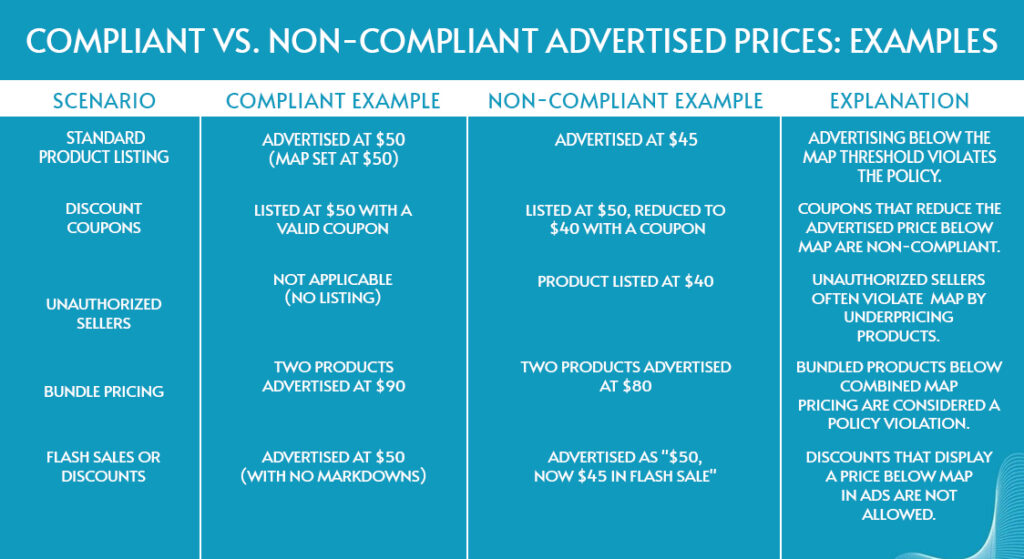Marketplace Expansion
What is a MAP Policy Violation?
When brands and retailers operate in competitive online marketplaces like Amazon, controlling the price at which their products are advertised is critical. A Minimum Advertised Price (MAP) policy plays a significant role in maintaining a brand’s value and ensuring fair competition. But what happens when a MAP policy is violated? Let’s explore this concept in detail and how it impacts Amazon 3P sellers.
Understanding MAP Policies
A Minimum Advertised Price (MAP) policy is a legal agreement between a manufacturer or brand owner and its authorized resellers. This policy sets the lowest price at which the reseller can advertise the product, either online or offline. While it does not restrict the actual selling price, it ensures that advertised prices maintain brand equity and prevent a “race to the bottom” in pricing.
For example, if a brand sets a MAP of $50 for a specific product, resellers cannot promote or advertise that product for less than $50. This does not mean, however, that the reseller cannot sell it for $45 privately—but they cannot publicly advertise it below the MAP.
MAP policies are especially important for high-end or luxury brands, as price erosion can harm their perceived value. For Amazon 3P sellers, MAP policies act as a safeguard, ensuring fair competition among resellers.

What Constitutes a MAP Policy Violation?
A MAP policy violation occurs when a reseller advertises a product below the agreed-upon minimum advertised price. Violations can happen for various reasons, such as deliberate attempts to undercut competitors or unintentional errors in pricing updates.
Here are some common examples:
- Discounted Advertising: A reseller advertises a product with a coupon or promotion that brings the advertised price below the MAP threshold.
- Third-Party Marketplace Listings: Unauthorized sellers list the product on platforms like Amazon at a lower price than allowed by the MAP.
- Price Comparison Tools: Tools or plugins that display prices below the MAP violate the policy.
- Bundles and Packages: Selling the product as part of a discounted bundle without complying with MAP guidelines.
These violations not only disrupt the pricing ecosystem but also create challenges for authorized sellers who follow the rules.

Why MAP Policy Violations Matter
MAP policy violations can have significant consequences for brands and sellers alike. Here’s why they matter:
- Brand Devaluation: When products are advertised below the MAP, it diminishes the perceived value of the brand. Consumers may associate the brand with lower quality, affecting its reputation.
- Erosion of Trust: Authorized sellers who comply with MAP policies lose trust in the brand when violators are not penalized. This can discourage them from continuing to sell the brand’s products.
- Pricing Wars: A single MAP violation can trigger a domino effect, leading to a pricing war among sellers. This reduces profit margins for everyone involved.
- Legal Risks: MAP policies must comply with antitrust laws. If poorly implemented, they can lead to legal disputes, especially if they’re perceived as price-fixing.

How to Detect MAP Policy Violations
For brands selling on Amazon, monitoring MAP compliance requires a proactive approach. Here are some effective ways to detect violations:
- Regular Price Audits: Use software tools to monitor advertised prices across all reseller platforms, including Amazon, eBay, and Walmart.
- Amazon Price Tracking Tools: Tools like Helium 10 and Jungle Scout can help track price changes and detect violations.
- Monitoring Unauthorized Sellers: Identify and track unauthorized sellers who might be undercutting your MAP pricing.
- Keyword Alerts: Set up alerts for your brand’s products to identify suspicious listings or promotions that violate MAP policies.

The Impact of MAP Violations on Amazon 3P Sellers
When MAP violations occur, they can have direct and indirect effects on Amazon 3P sellers. These include:
- Loss of Buy Box: MAP violators often undercut pricing, making it harder for compliant sellers to win the Buy Box, which is critical for driving sales.
- Reduced Margins: Violations force compliant sellers to lower their prices to compete, leading to slimmer profit margins and potentially unsustainable business practices.
- Damaged Relationships: Resellers violating MAP policies risk damaging their relationship with the brand owner, which could result in the termination of distribution rights.
- Increased Competition from Unauthorized Sellers: When unauthorized sellers violate MAP policies, it further complicates the marketplace and creates an uneven playing field for authorized resellers.
How to Prevent MAP Policy Violations
Preventing MAP violations requires a combination of strategic planning, effective communication, and enforcement. Here are actionable steps you can take:
- Implement Strong Agreements: Clearly outline your MAP policy in contracts with resellers, making sure it’s legally sound and easy to understand.
- Automate Price Monitoring: Use automated tools to monitor advertised prices across multiple platforms in real time. This minimizes the risk of manual errors and ensures swift detection of violations.
- Enforce Penalties Consistently: Establish clear consequences for MAP violations, such as suspending reseller rights, issuing warnings, or pursuing legal action when necessary.
- Educate Your Resellers: Host training sessions and provide resources to help resellers understand the importance of MAP compliance and how it benefits their business.
- Monitor Unauthorized Sellers: Identify and address unauthorized sellers on platforms like Amazon. This includes using tools to track their activity and taking appropriate action to remove their listings.


Best Practices for Addressing MAP Violations
If a violation is detected, it’s crucial to respond quickly and effectively. Here’s how:
- Document Evidence: Collect screenshots, pricing data, and other relevant information to document the violation.
- Contact the Reseller: Notify the reseller of the violation and request immediate compliance. Provide clear details about the infraction and its consequences.
- Enforce Penalties: If the reseller fails to comply, take appropriate action as outlined in your MAP policy agreement.
- Strengthen Brand Protection: Use tools and services designed to monitor and protect your brand, ensuring long-term MAP compliance.

How Prime Retail Solution Helps with MAP Policy Management
Managing MAP policies can be a complex and time-consuming task. Prime Retail Solution offers expert services to help brands and 3P sellers protect their pricing strategy and brand equity. Here’s how we can assist:
- Advanced Monitoring Tools: We use cutting-edge software to track prices and detect MAP violations across multiple platforms.
- Enforcement Support: Our team works with you to address violations, contact resellers, and ensure compliance.
- Unauthorized Seller Management: We help identify and remove unauthorized sellers, protecting your brand’s value.
- Custom Strategies: We develop tailored solutions to meet the unique needs of your business, ensuring effective MAP policy implementation.
With Prime Retail Solution, you can focus on growing your brand while we handle the complexities of MAP compliance.
Conclusion
MAP policies are essential for maintaining brand integrity and ensuring fair competition in the Amazon marketplace. Understanding what constitutes a MAP policy violation, its consequences, and how to address it is crucial for any brand owner or 3P seller.
If you’re struggling to enforce your MAP policy or detect violations, Prime Retail Solution is here to help. Contact us today to safeguard your brand’s value and optimize your Amazon strategy. Let’s work together to protect your business and maintain consistent pricing across all channels
Share





